Shoe socks for infants combine the comfort of socks with the grip and protection of soft-soled shoes, making them perfect for babies who are crawling, cruising, or taking their first steps. This guide is designed for new parents, caregivers, and anyone shopping for babies aged 3 months to 24 months who want to keep little feet safe, warm, and supported during those exciting early mobility milestones.
We’ll walk you through the essential features that make quality infant shoe socks worth buying, including non-slip soles, breathable materials, and proper sizing considerations. You’ll also discover which materials work best for different stages of development and learn the key safety factors to watch for when making your selection. By the end, you’ll know exactly what to look for to find shoe socks that support your baby’s natural foot development while providing the protection they need.
Understanding Infant Shoe Sock Basics
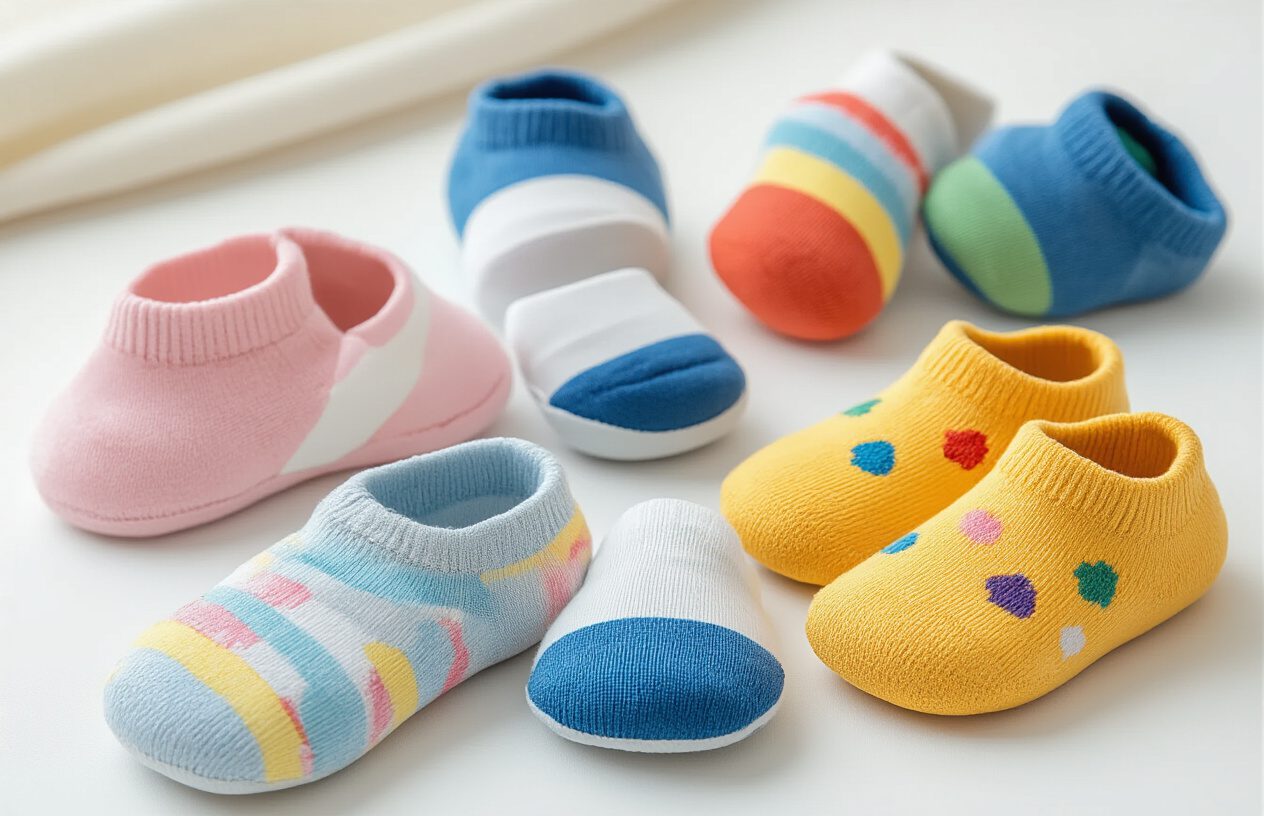
What Makes Shoe Socks Different from Regular Baby Socks
Shoe socks for infants are specifically designed with unique features that set them apart from traditional baby socks. The most noticeable difference lies in their sole construction – shoe socks feature reinforced, non-slip soles made from rubber or silicone materials that provide traction and grip. This specialized bottom creates a barrier between your baby’s feet and various surfaces, offering protection while maintaining the flexibility that regular socks provide.
Unlike regular baby socks that often slide around or bunch up during crawling and early walking attempts, shoe socks stay securely in place thanks to their snug ankle design and heel reinforcement. The upper portion typically uses breathable cotton or bamboo blends, while the sole incorporates durable materials that can withstand repeated contact with floors, carpets, and outdoor surfaces.
Many shoe socks also feature fun, shoe-like designs on top – complete with lace patterns, buckle graphics, or sneaker styling – making them look like miniature shoes from above. This aesthetic appeal means your little one can look dressed up without the restriction of actual footwear.
Key Benefits for Your Baby’s Foot Development
Shoe socks for infants support natural foot development in ways that traditional shoes cannot match. They allow tiny toes to move freely, grip surfaces naturally, and develop the small muscles needed for balance and coordination. This unrestricted movement helps babies learn proper walking mechanics while their feet are still forming.
The flexible construction encourages proprioception – your baby’s ability to sense their body position and movement. When infants can feel the ground beneath their feet, they develop better spatial awareness and balance control. The thin, flexible sole maintains this crucial sensory connection while providing just enough protection from rough or dirty surfaces.
Temperature regulation becomes easier with shoe socks since they allow air circulation around the foot, preventing the overheating that can occur with closed-toe shoes. This breathability reduces the risk of fungal infections and keeps little feet comfortable throughout the day.
The non-restrictive design also prevents the toe crowding and heel elevation that can occur with traditional infant shoes, supporting the natural foot shape during this critical development period.
When to Start Using Shoe Socks for Your Infant
The ideal time to introduce shoe socks depends on your baby’s mobility and environmental needs. Most babies benefit from shoe socks once they begin crawling actively, typically around 6-9 months. At this stage, they’re moving across various surfaces and need protection from splinters, rough textures, and temperature extremes while maintaining the barefoot benefits.
Pre-walkers (8-12 months) find shoe socks particularly helpful as they pull themselves up and cruise along furniture. The grip provided by the sole prevents slipping on smooth floors like hardwood or tile, giving babies confidence to explore upright movement safely.
Early walkers (10-15 months) can transition between barefoot time at home and shoe sock protection when needed. This flexibility allows parents to provide foot protection during outings to parks, stores, or other public spaces without committing to rigid footwear.
Consider your living environment when deciding timing – families with primarily carpeted homes might delay introduction, while those with hard flooring surfaces often find shoe socks beneficial earlier. Climate also plays a role, as shoe socks provide warmth in cooler months while maintaining breathability.
Essential Features to Look for in Quality Infant Shoe Socks
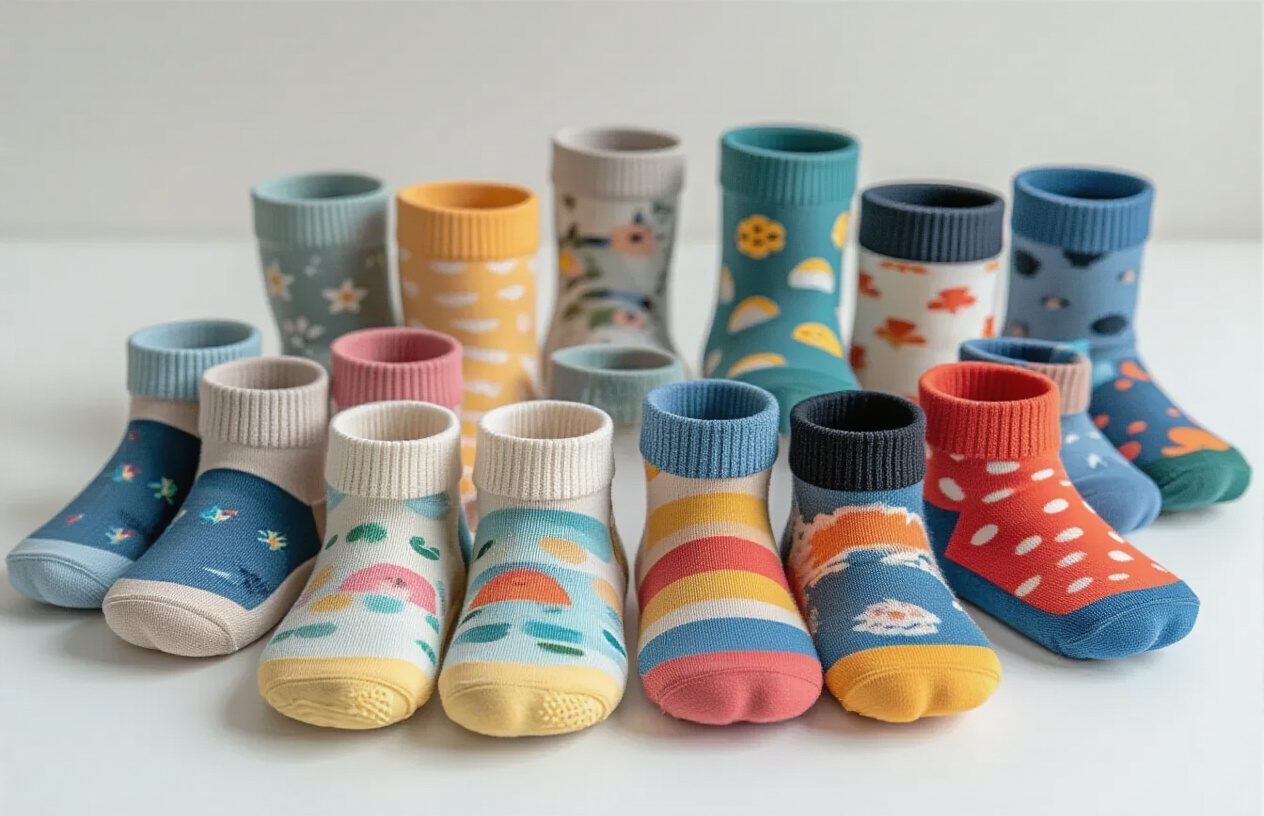
Non-Slip Grip Soles for Safety and Stability
Grip soles make all the difference when your baby starts standing and taking those first wobbly steps. Quality shoe socks for infants should feature textured dots, patterns, or treads on the bottom that provide traction on smooth surfaces like hardwood floors or tiles. These grip patterns prevent dangerous slips that could lead to falls and injuries.
Look for grip soles made from silicone or rubber materials that maintain their effectiveness even after multiple washes. The grip pattern should cover the entire sole area, not just scattered dots here and there. Well-designed grips help your little one build confidence while walking and provide the stability they need during their crucial developmental phase.
Breathable Materials That Keep Feet Dry and Comfortable
Baby feet get sweaty quickly, especially when they’re active or wearing closed shoes. The best shoe socks for infants feature moisture-wicking properties that pull sweat away from delicate skin. Natural fibers like bamboo, cotton, and merino wool excel at breathability while synthetic blends often trap moisture and heat.
Mesh panels or breathable weave patterns allow air circulation around tiny toes. This prevents bacterial growth, reduces odor, and keeps feet comfortable throughout the day. Avoid thick, non-breathable materials that can cause overheating and create uncomfortable, damp conditions inside shoes.
Proper Fit and Sizing Guidelines
Getting the right size prevents blisters, restricted circulation, and discomfort. Measure your baby’s feet regularly since they grow incredibly fast during the first two years. The sock should fit snugly without being tight, with about a thumb’s width of space at the toe area.
Check these fit indicators:
- No bunching or sliding inside shoes
- Toes can move freely without restriction
- No red marks around the ankle or leg after removal
- Heel stays in place during movement
Many parents size up slightly to accommodate growth, but avoid going too large as loose socks can cause blisters and reduce the effectiveness of grip soles.
Flexible Construction for Natural Foot Movement
Babies need to feel the ground beneath their feet to develop proper balance and coordination. Stiff, rigid socks interfere with natural foot development and can actually delay walking skills. Choose shoe socks with flexible construction that bends and moves with your baby’s foot.
The sock should allow full range of motion for ankle flexion and toe movement. Seams should be flat and positioned away from pressure points. Elastic bands around the ankle should be gentle enough to stay in place without cutting off circulation or leaving marks.
Easy-to-Clean and Durable Fabric Options
Baby socks get dirty fast and need frequent washing. Select materials that can handle regular machine washing without losing their shape, grip, or softness. Pre-shrunk fabrics maintain their size and fit after multiple wash cycles.
Quality construction features include:
- Reinforced heel and toe areas for extra durability
- Colorfast dyes that won’t bleed or fade
- Machine washable materials that dry quickly
- Stretchy but shape-retaining elastic components
Avoid socks that require hand washing or special care instructions – you’ll have enough laundry challenges with a baby without adding complicated sock care to your routine.
Age-Appropriate Selection Guide
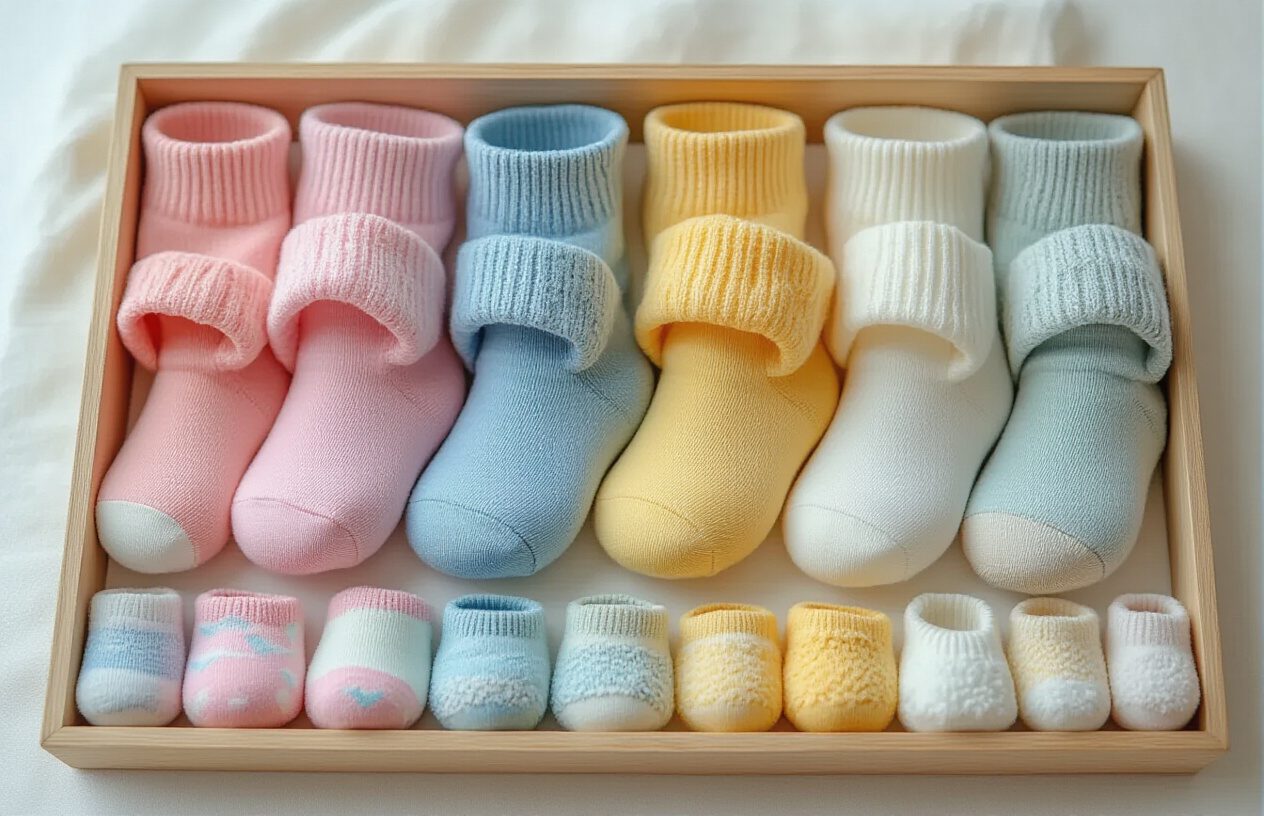
Newborn to 6 Months: Ultra-Soft Options for Delicate Feet
Your tiny newborn’s feet are incredibly delicate, so choosing shoe socks for infants at this stage requires special attention to softness and comfort. The skin on a baby’s feet is about five times thinner than adult skin, making gentle materials absolutely essential.
Look for shoe socks made from organic cotton blends or bamboo fibers. These materials feel cloud-like against sensitive skin and won’t cause irritation or chafing. The best options for this age group feature seamless toe construction, which prevents uncomfortable pressure points that could make your little one fussy.
At this stage, your baby isn’t walking or even crawling yet, so grip isn’t a priority. Instead, focus on breathability and temperature regulation. Newborns have trouble regulating their body temperature, and their feet are often the first to get cold or overheated. Choose shoe socks with moisture-wicking properties that keep tiny feet dry and comfortable.
Pay attention to the sock opening design too. Wide, stretchy openings make diaper changes easier and prevent the socks from cutting into your baby’s delicate ankles. Many parents love fold-over cuffs that stay put without being too tight.
6 to 12 Months: Enhanced Grip for Early Standing
As your baby enters the second half of their first year, everything changes. They’re likely sitting up, crawling, and pulling themselves to standing positions. This is when shoe socks for infants need to step up their game with enhanced grip features.
Non-slip grips on the bottom become crucial during this stage. Look for silicone or rubber grip patterns that cover the entire sole area, not just small dots. Your baby will be testing their balance and trying to stand, so they need all the traction they can get on smooth floors.
The material should still be soft but can handle more durability demands. Cotton-polyester blends work well because they maintain comfort while offering better shape retention after multiple washes. Your baby will be more active, so the socks need to stay in place during all their adventures.
Consider socks with reinforced heel and toe areas. These high-wear zones need extra protection as your baby becomes more mobile. Some parents find that socks with light compression around the arch area help support developing feet without restricting natural movement.
12+ Months: Sturdy Support for First Steps
Once your toddler starts walking, their shoe sock needs completely transform. Walking babies need sturdy support that can handle the demands of those wobbly first steps and increasingly confident strides.
The grip becomes even more important at this stage. Look for aggressive tread patterns that work on various surfaces – hardwood, tile, carpet, and even outdoor patios. The grip material should be thick enough to provide cushioning but flexible enough not to interfere with natural foot movement.
Support features become essential now. Many quality shoe socks for infants in this age group include light arch support and cushioned soles. These features help support proper foot development while providing comfort during those early walking adventures.
Durability moves to the front of your priority list. Toddler socks take a beating from constant walking, running, and playing. Choose socks with reinforced construction throughout, especially in the toe and heel areas. Double-stitched seams prevent unraveling, and quality materials maintain their shape and grip effectiveness through countless washes.
The height might matter more now too. Crew-length socks can provide ankle support and stay put better under shoes when you transition to outdoor adventures.
Top Materials and Their Benefits
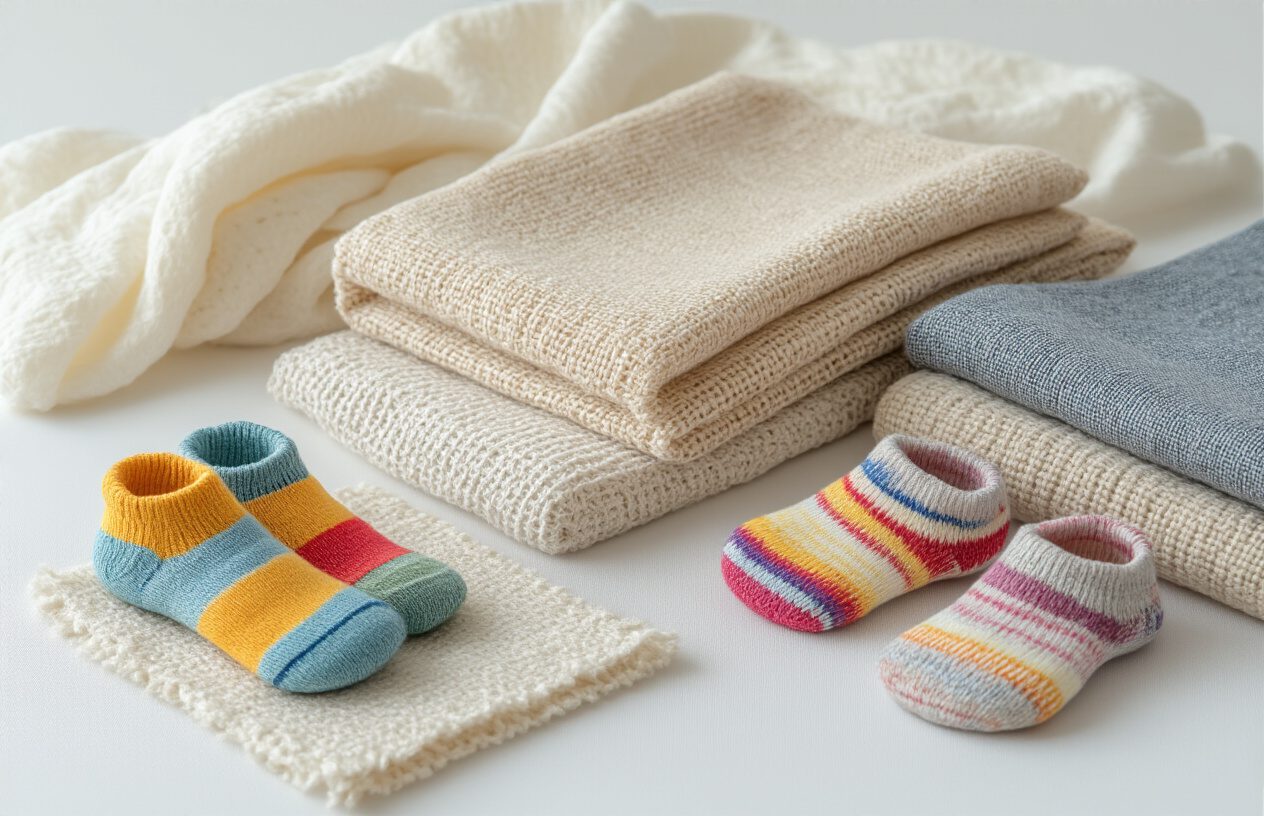
Organic Cotton for Sensitive Skin Protection
Organic cotton stands as the gold standard for shoe socks for infants with delicate skin. This natural fiber undergoes cultivation without harmful pesticides, chemical fertilizers, or toxic processing agents that could irritate your baby’s sensitive feet. The breathable nature of organic cotton allows air circulation while maintaining gentle contact with skin, reducing the risk of allergic reactions and contact dermatitis.
The soft texture of organic cotton provides cushioning without being too thick, making it perfect for babies who are learning to walk or spend time in shoes. This material naturally regulates temperature, keeping tiny feet cool in warm weather and providing insulation during cooler months. Parents often notice that organic cotton shoe socks maintain their shape better after washing, providing consistent comfort and fit over time.
What makes organic cotton particularly valuable is its hypoallergenic properties. Babies with eczema, sensitive skin, or known fabric allergies typically respond well to this material. The absence of chemical treatments means there’s no residual irritant that could cause redness, itching, or discomfort during extended wear.
Bamboo Fiber for Natural Antimicrobial Properties
Bamboo fiber brings unique antimicrobial benefits that make it exceptional for infant footwear. This sustainable material naturally contains “bamboo kun,” a bio-agent that resists bacteria and fungi growth. For active babies whose feet tend to get sweaty, this natural protection helps prevent odor buildup and reduces the likelihood of fungal infections.
The silky smooth texture of bamboo fiber feels luxurious against baby skin while providing excellent moisture management. Unlike synthetic materials that can trap humidity, bamboo fiber wicks moisture away from skin and allows it to evaporate quickly. This keeps feet dry and comfortable throughout the day, which is especially important for babies who wear shoes for extended periods.
Bamboo grows rapidly without requiring pesticides, making it an eco-friendly choice for environmentally conscious parents. The fiber is naturally UV-resistant and maintains its antimicrobial properties even after multiple washes. Many parents report that bamboo shoe socks stay fresher longer between washes compared to other materials.
Moisture-Wicking Synthetic Blends for Active Babies
Synthetic blends engineered for moisture-wicking offer superior performance for highly active infants and toddlers. These specially designed fabrics typically combine polyester or nylon with natural fibers to create a material that pulls sweat away from skin and moves it to the outer surface where it can evaporate quickly.
For babies who crawl extensively, cruise along furniture, or have started walking, moisture-wicking blends prevent the clammy feeling that can develop in traditional cotton socks. The quick-dry properties mean parents don’t have to worry about damp feet leading to discomfort or skin issues during long play sessions or outings.
Modern synthetic blends designed for infants often incorporate silver ions or copper threads for additional antimicrobial protection. These materials tend to be more durable than pure natural fibers, maintaining their stretch and shape even with frequent washing. The enhanced durability makes them cost-effective for parents dealing with rapidly growing babies who need frequent size changes.
The compression provided by quality synthetic blends can also offer gentle support for developing feet and ankles, though parents should ensure the fit isn’t too tight to restrict proper circulation or natural foot development.
Safety Considerations and Red Flags to Avoid
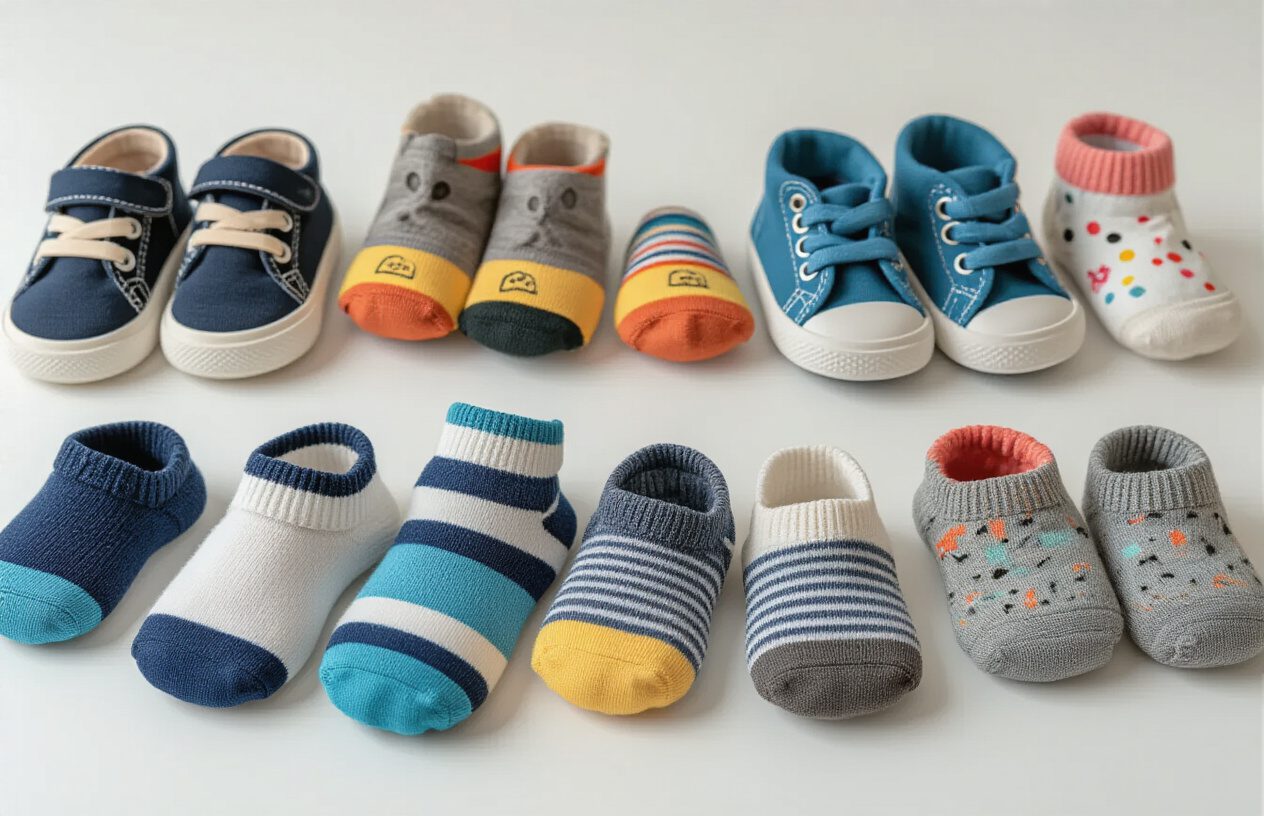
Avoiding Loose Threads and Choking Hazards
When shopping for shoe socks for infants, inspect every pair carefully for loose threads, decorative elements, or poorly secured seams. Babies naturally explore their world by putting everything in their mouths, and loose threads pose a serious choking risk. Run your fingers along all seams and edges, checking for any protruding materials that could come loose during wear or washing.
Pay special attention to decorative elements like bows, buttons, or appliqués. These cute additions often become safety hazards when they detach from the fabric. Choose shoe socks with minimal embellishments, or ensure any decorative features are firmly embedded into the fabric rather than simply sewn on top.
Look for reinforced toe and heel areas that maintain their structure without creating loose material. Quality shoe socks should have clean, tight stitching throughout, with no fraying edges or hanging threads right out of the package.
Checking for Proper Toe Room and Circulation
Proper fit prevents circulation problems and supports healthy foot development in growing babies. The sock should allow your infant’s toes to move freely without being compressed or restricted. Gently press on the toe area of the sock while your baby wears it – you should feel their toes moving naturally underneath.
Watch for red marks around your baby’s ankles, toes, or the top of their feet after removing the socks. These marks indicate the socks are too tight and could restrict blood flow. The elastic bands should be snug enough to stay in place but loose enough that you can easily slip a finger underneath.
Check that the sock length matches your baby’s foot properly. Too-short socks cramp the toes, while overly long socks can bunch up inside shoes and create uncomfortable pressure points. The heel of the sock should align with your baby’s heel, and there should be about a thumb’s width of space beyond their longest toe.
Identifying Signs of Poor Quality Construction
Poor construction in shoe socks for infants shows up in several telltale ways. Uneven seams create uncomfortable ridges against delicate skin and often indicate rushed manufacturing. Quality socks feature flat, smooth seams that won’t irritate or create pressure points.
Thin, flimsy fabric tears easily and provides inadequate protection for tiny feet. Good infant shoe socks should feel substantial without being bulky. The fabric should maintain its shape after stretching and return to its original form quickly.
Inconsistent elastic tension is another red flag. Some areas might be too loose while others are uncomfortably tight. Run the sock through your hands, feeling for any areas where the elastic feels different or where the fabric puckering suggests uneven construction.
Look for socks that maintain their color and shape after the first wash. Quality materials and construction methods ensure the socks won’t shrink significantly, fade excessively, or lose their elasticity after normal care. Avoid socks with chemical odors or those that feel scratchy against your skin, as these often indicate poor quality materials or finishing processes.
Maintenance and Care Tips for Longevity
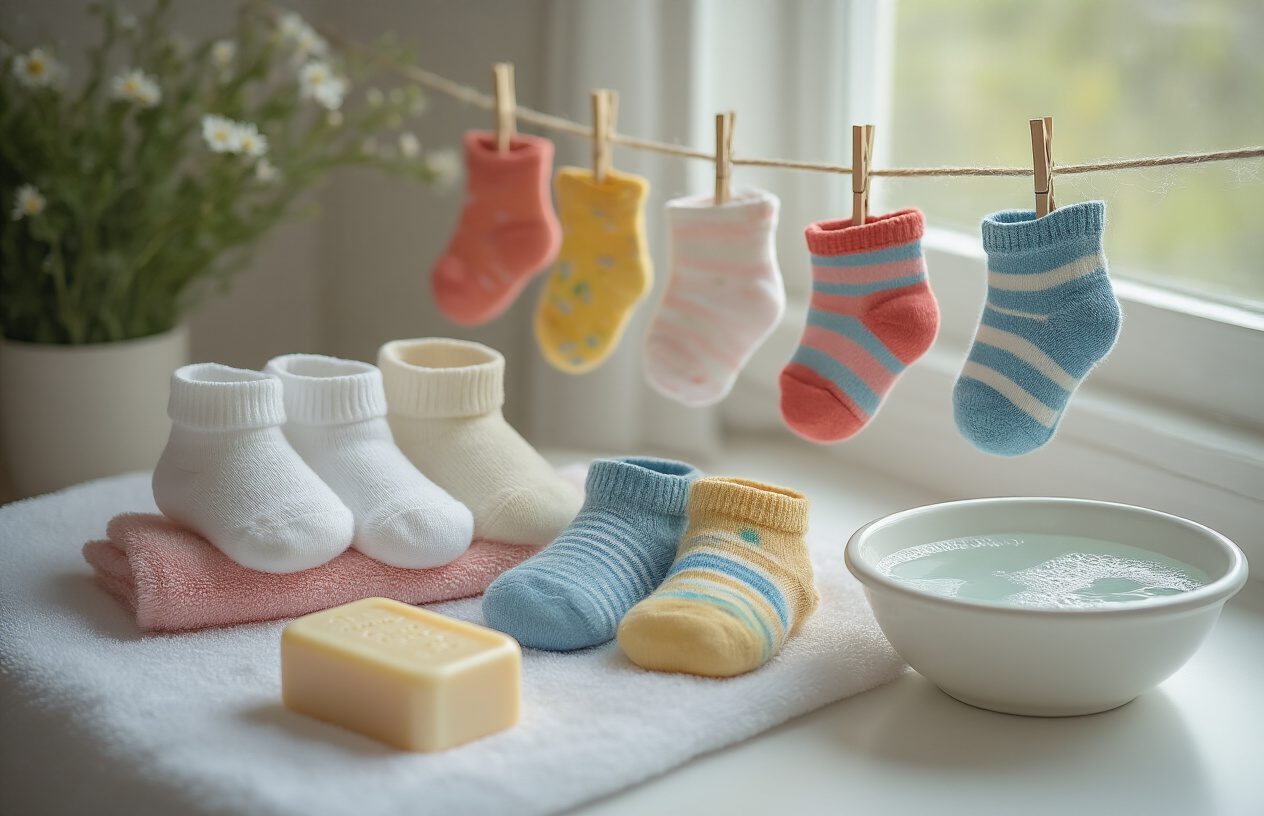
Washing Instructions to Preserve Grip and Shape
Proper washing keeps shoe socks for infants grippy and well-fitted. Always turn them inside out before tossing them in the machine – this protects those precious grip dots from wearing down too quickly. Cold water is your best friend here, as hot water can break down the rubber grips and cause shrinkage.
Skip the fabric softener completely. While it makes regular clothes feel nice and fluffy, it creates a slippery coating on grip soles that defeats the whole purpose of non-slip socks. Instead, use a gentle, baby-safe detergent that won’t irritate your little one’s sensitive skin.
Air drying works best for maintaining shape and grip integrity. High heat from the dryer can warp the rubber dots and cause the fabric to lose its elasticity. If you must use a dryer, choose the lowest heat setting and remove them while they’re still slightly damp.
Wash these socks separately from items with hooks, zippers, or rough textures that might snag the delicate fabric. A mesh laundry bag offers extra protection during the wash cycle.
Storage Methods to Maintain Sock Integrity
Smart storage prevents your infant shoe socks from losing their shape between wears. Roll them loosely rather than folding – this prevents creases that can weaken the fabric over time. Avoid tight bundling that stretches the elastic cuffs.
Keep them in a breathable container or drawer section where air can circulate. Plastic bags trap moisture and can lead to unpleasant odors or mildew, especially if the socks weren’t completely dry when stored.
Organize by size rather than mixing different sizes together. This prevents smaller socks from getting stretched when tangled with larger ones. A simple drawer divider or small basket system works perfectly for keeping pairs together.
Store them away from direct sunlight, which can fade colors and weaken elastic fibers over time. Room temperature storage in a dry location maintains the material’s flexibility and grip quality.
When to Replace Worn-Out Shoe Socks
Watch for worn grip dots – once they start peeling or becoming smooth, it’s time for new ones. Smooth grips create a slipping hazard that defeats the safety purpose of these specialized socks. Even if the fabric looks fine, compromised grips mean replacement time.
Check the elastic regularly. When cuffs become loose and won’t stay up on your baby’s legs, or if they leave marks from being too tight, the elastic has lost its proper tension. Socks that constantly slide down or bunch up create discomfort and potential tripping hazards.
Look for holes, even tiny ones. Baby toenails can create small punctures that quickly become larger tears with continued wear. Thin spots in high-wear areas like heels and toes signal the fabric is breaking down.
Stretching that doesn’t bounce back indicates the sock has exceeded its useful life. If you can stretch the fabric and it stays stretched instead of returning to its original shape, the fibers have broken down beyond effective use.
Replace socks immediately if you notice any fraying around seams or if the colors start bleeding onto your baby’s feet during wear.
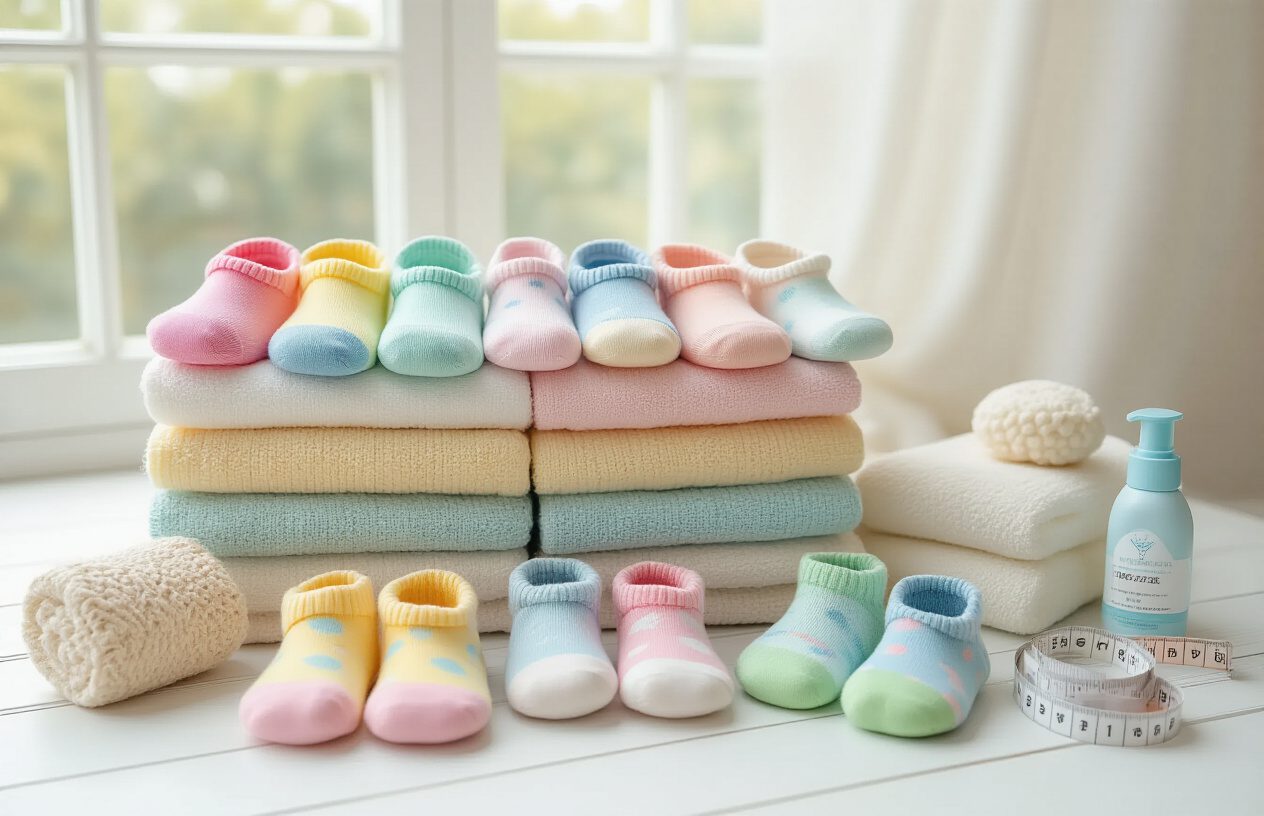
Finding the right shoe socks for your little one doesn’t have to be overwhelming. The key factors come down to choosing breathable materials like cotton or bamboo, making sure the fit isn’t too tight around those tiny ankles, and looking for non-slip grips that actually work. Remember to check for any rough seams or loose threads that could irritate your baby’s delicate skin, and always go with your gut if something doesn’t seem right.
Take your time when shopping and don’t be afraid to feel the fabric quality before buying. Your baby’s comfort and safety are worth the extra effort. With proper care and washing, good quality infant shoe socks will last through countless adventures and can even be passed down to future little ones. Start with a few pairs to test what works best for your child, then stock up on the winners.





